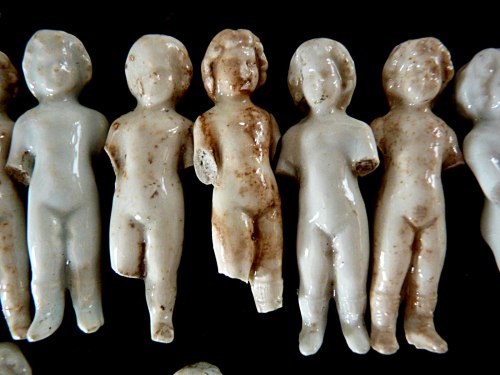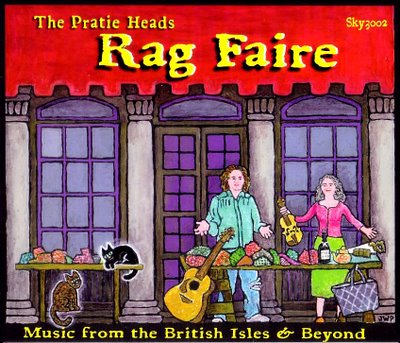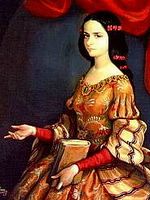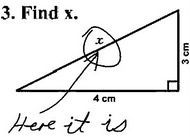UPDATE: Reposting to add the video I just made of this song, which is on our "Under the Drawbridge" cd available at Bandcamp:
Let Memory Keep Us All. Here's the video:
 The Solstice Assembly Songbook: 66 songs to sing in harmony
The Solstice Assembly Songbook: 66 songs to sing in harmony
Choral arrangements for folksong lovers

This is a picture of Mitzi, Mona, and Sandy at the Medieval Fair at the Castle McCullough in Jamestown, NC, back in the 1990s, wearing nice outfits we sewed out of cloth we dyed ourselves.
There were usually about sixteen people in the Solstice Assembly, a mainly
a cappella ensemble. Everybody had a busy professional life elsewhere but we made three recordings and performed at Piccolo Spoleto and an annual "Solstice Extravaganza," which was a little like the Christmas Revels except it included Hannukah and Winter Solstice music too.
I disbanded the group in the mid 1990s but I still miss it... so I put together a songbook of our best music. I hope some of you will enjoy this sheet music, suitable for small groups or a chorus or chorale.

BUY THE BOOK AT LULU OR AMAZON:
Let Memory Keep Us All: full size and spiral bound at Lulu.com ($15.80)...
Somewhat smaller, somewhat cheaper, and perfect-bound, at Amazon.com ($13.05)
Or buy the pdf format digital download book directly from me for $7 via PayPal:

This picture (left) is of Carol Boren Owens: the woman
Let Memory Keep Us All was written for. Carol was one of the original sopranos with the Solstice Assembly, a beautiful, kind, funny, sassy Southern girl with deep roots in the Chapel Hill area.
Everybody loved her and she had a wonderful voice.
She was only 33 years old when she died instantaneously. We had finished taping and mixing our first recording, "Three Log Night," but she died before she had a chance to hear it. When we met to listen to the mixes we were stunned into silence listening to her beautiful solos. We have never forgotten her.
That's my daughter Hannah, in a homemade hennin, holding her hand. The picture was taken at the Renaissance Fair at Castle McCullough in Jamestown, NC.
Below, brief descriptions of the songs in the book. If we recorded the song, you can click to hear (or purchase) the mp3.
The Agincourt Carol: I heard this from the singing of
Graeme and Eileen Pratt on their album Regal Slip (it's great). It was written in the early 15th century and tells of the 1415 Battle of Agincourt, in which the English army led by Henry V of England defeated the French.
 An Equal Song
An Equal Song: I combined the Sacred Harp song "Poor Mourning Souls" with lyrics from another Sacred Harp song, both slightly, uh, reorganized.
Away with these self-loving lads: By lutenist John Dowland, from his 1597
First Booke of Songs or Ayres, arranged by me and Doug Holmgren (who played the sprightly harpsichord setting). "My songs they be of Cynthia's praise, I wear her rings on holidays, On every tree I write her name, and ev'ry day I read the same ... If Cynthia crave her ring of me, I'll blot her name out of the tree!" Somethings never change. The track is from
Courting Disaster, a cd I did with Beth Holmgren in 1991. (In this case, click on the title of the song to hear it.)
Ayo visto lo mappamundi: I heard this on the Waverly Consort's
1492: Music From The Age Of Discovery and was enchanted. "I have seen the map of the world... I've been everywhere ... but there's nobody as cute as my girlfriend Cecily." I arranged it for the Solstice Assembly and later did it with my world music band, and that's where we got our name!
Barrett's Privateers: I arranged this one, written by Stan Rogers and brought to me by Mark Biggers, for the kids chorus at the Emerson Waldorf School and later did it with the teen traveling camp at Village Harmony.
Brave Wolfe: This one is in many songbooks because it is historically significant: General James Wolfe triumphed at the battle of the Plains of Abraham outside Quebec and it turned the course of the war.
Brightly Dawns our Wedding Day: Four of us from the Solstice Assembly sang this song (from the Mikado) for Ed Norman's wedding and I taught it at the Village Harmony Adult Camp a few years ago. I've always wanted to do it at another wedding but the words are a little strong for present-day brides: "All must sip the cup of sorrow, I to-day and thou to-morrow, this the close of every song. What, though solemn shadows fall - sooner, later - over all? Sing a merry madrigal!..."
The Bundling Song: This was an invention. When I was researching music of Colonial America for the Pratie Heads North Carolina Arts Council Touring Program performances, I ran across the text in an old book. Now you can read the whole thing on line:
A New Bundling Song, or, A Reproof To Those Young Country Women, Who Follow That Reproachful Practice, And To Their Mothers For Upholding Them Therein! I made up a tune and a harmony for it and pared it down mercilessly (the parson who wrote it had a bit of an obsession) and we sang it to the great amusement of all. My favorite couplet: "Bundlers' clothes are no defense - unruly horses push the fence!"
Cadgwith Anthem: We learned this from Mark Biggers, who loved Fairport Convention and Steeleye Span, and a quartet of us recorded it on "Under the Drawbridge"
Ce mois de mai: Mitzi Quint brought us this one, a madrigal by Clement Janequin.
Claudy Banks: Ken Bloom gets us to sing this at his Revolutionary War reenactments. A soldier comes back from war and, meeting up with his old girlfriend (but unrecognized by her) says "Your boyfriend is dead" -- just to see her get upset. Then he says "Just Kidding!" If I were her I'd conk him over the head.

The Solstice Assembly at the Piccolo Spoleto Festival, 1992: Alice Kaplan, Ben Bingham, Candace Carraway, Doug Holmgren, Ed Norman, Jane Peppler, Joe Sickles, Jon Newlin, Laurie Fox, Lisa Pickel, Mark Biggers, Mitzi Quint, Paula, Randy Kloko, Rivka Gordon, Rob Rich, Stacey Anderegg. We used this photo on our third recording:
Some Assembly Required: Centuries of great vocal music.
: Incredibly,
Mappamundi got a gig at the Hollywood Bowl in Los Angeles! Well, truth to tell, we were not actually IN the bowl, we were in a little theater NEXT to the bowl, doing a week-long show for families on American History through music. The lady who hired us, Marnie, found this song and I tweaked it and re-arranged it quite a bit. The idea is, even the rich masters for whom the servants work are slaves to somebody or something. "The fat shining glutton looks up to his shelf, the wrinkled lean miser bows down to his pelf, and the churl-pated beau is a slave to himself" Vocabulary word I learned from this song, pelf: "Wealth or riches, especially when dishonestly acquired."
Come, Lasses and Lads: This was a bringing-together of the 1670 Playford English Country Dance tune, Epping Forest, with the text of a John Roberts and Tony Barrand song. I recorded it with genius pianist Jacqueline Schwab and bassist Robbie Link.
Con el viento: Somebody in the Solstice Assembly heard Libana sing this song and I transcribed it as best I could. We recorded it on "Some Assembly Required" and you can also hear Libana sing it at
YouTube
Daniel Prayed: A Red Clay Ramblers favorite which I also did with the Triangle Jewish Chorale. Here's a similar (but all-men) arrangement sung by Joe Newberry, Jim Watson, Bill Hicks & Mike Craver at
YouTube
Devotion: A Sacred Harp song.
Down with the Rosemary and Bays: Mark Biggers brought us this song. First I made a three part version and then a four-part version. Words by Robert Herrick, song is from William Henry Husk's 1868 Songs of the Nativity.
Drive Dull Care Away (traditional version): Mid-1970s, a folksinging circle in Cambridge sponsored by the Folksong Society of Greater Boston (ah, why don't we have one of those down here in North Carolina?). I heard this song and was riveted. That being pre-internet, I ended up having to make several phone calls (which I hate) and then drive 35 miles to grab this song from the guy who sang it. Now it's probably just a mouse-click away. I love the lyrics so much that I wrote another setting and recorded it on Some Assembly Required.
 Durme, durme
Durme, durme: This gorgeous Sephardic song, sung in Laduvane, has been recorded many times, I first heard it on Judy Frankel's cd Stairway of Gold: Songs of the Sephardim. The Solstice Assembly sang my
a cappella version for many years and the Triangle Jewish Chorale loved the song too.
Fine Knacks for Ladies: This is from John Dowland, too, and I wrote this arrangement when we were asked to do an Elizabethan gig - some of the songs we scrabbled together were a bit, uh, spurious, but this one was the real thing.
Fortune, My Foe: Supposedly Henry V wrote this, but I bet he just stole credit for it. Still happens all the time.
CD Review magazine said about the Solstice Assembly's Under the Drawbridge:
An all-seasons follow-up to Three Log Night, a regional Christmas favorite, Under the Drawbridge is an impressive introduction to the elegant, elastic vocal stylings of North Carolina's Solstice Assembly, an inventive 18- voice choral group that specializes in updating folk songs that span the last 800 years. These modern minstrels, favorites on the East Coast Renaissance festival circuit ... whether singing a cappella or accompanied by guitars, fiddles, percussion and recorders, showcase forceful harmonies with reverent relish and a youthful spirit. The alternately festive, romantic, and haunting arrangements mirror a variety of familiar vocal settings, including madrigal choruses, barbershop quartets, even such peers as the Bobs and the Roches... The most lasting pleasures ... are the older songs, all performed with an earnest affection that accents their beauty rather than their age.
Furry Day Carol: learned from Dave DiGiuseppe, friend of the Nee Ningy band, former member of the Band of Ages, the Banished Fools, the Big Zucchini Washboard Bandits, and a Mayday organizer. We did a Mayday concert with him and sang this song.
Gaude Mater Polonia: Ed Norman learned this one in high school. Wikipedia says: "It was probably the most popular medieval Polish hymn, written in the 13th-14th century in memory of saint Stanislaw Szczepanowski, bishop of Kraków." Polish knights used to sing it after victory in battle. Since Ed is from Alabama, not Krakow, the words may be a bit folk-processed.
Give Me the Roses: learned from Mike Craver of the Red Clay Ramblers. I wrote this arrangement for us to perform at a musical lecture Jack Bernhard gave at the Ulster-American Park when a bunch of us went over to Northern Ireland to sing Sacred Harp at their bluegrass festival.
Golly: I ordinarily fear rounds - I always wonder,
what if it never stops? - but this one, by P.D.Q. Bach I think, is cute.
Good in Living: It was Stacey Anderegg, now leader of the Stella ensemble, who brought us this song.
Hard Times, Come Again No More: Somebody asked us to learn this Stephen Foster song. The Red Clay Ramblers used to do a wonderful version of it but their arrangement wouldn't work for mixed mens and womens voices so I wrote one for us.
Haymaking: Mark Biggers and Randy Kloko sang this song, which we learned from John Roberts and Tony Barrand.
The Hock Cart: I sort of wrassled this melody together out of a fragment of a medieval melody which I pushed and prodded until it wasn't really recognizable, then added an Elizabethan text.
How Stands the Glass Around?: Learned for Early American gigs. I arranged it for four-part choral singing. The song was collected from the notebook of Thomas Fanning, 1780. It was General Wolfe's favorite song. Recording by the Pratie Heads.
Imi Nahtna Leviva-Li: One of the first Hannukah songs we learned for the Solstice Extravaganza.
In Sherwood Lived Stout Robin Hood: Another one learned for a Renaissance Fair. By Robert Jones, 1609. I love this tune so much I made it the ringtone for my phone.
Cue Magazine wrote:
The Solstice Assembly then took the stage, and I mean TOOK IT, with an earthy vocal/choral style that reaches far back into folk traditions. Their singing tone is a full-throated delivery that commands attention and delivers great excitement and driving energy."
: This is one of several songs I concocted for an Elizabethan evening. The text, of course, is by Shakespeare. The tune was kludged together out of a Welsh folksong I'd mostly forgotten.
Let Memory Keep Us All: The song that inspired this lens. The tune was learned from Peter Bellamy's
The Death of Admiral Nelson and I wrote the words with some input from my then-husband.
Let Us Drink and be Merry: A round I learned from the singing of Suzy Liebert, a long-ago roommate.
Love Is Come Again: From the Oxford Book of Carols. One verse was written by our tenor Ben Bingham.
Margot Labourez les Vignes: Alice Kaplan, Professor of French Literature at Duke and one of our sopranos, helped with the words of this song, which I'd known since highschool. It was originally a folksong but was turned into a madrigal by Jacob Arcadelt (or was it Orlando di Lasso?)
Northfield: One of everybody's favorite Sacred Harp songs. Words: Isaac Watts, 1701; music: Jeremiah Ingalls, 1800
Northill May: Perhaps I heard the Watersons do this on a long-ago LP, or maybe it was the Young Tradition?
O My Hart: Henry VIII claimed the authorship of this one. Yeah, right. See Henry V, above.
Ode to the Fourth of July: Written in 1803 by Walter Townsend, arranged by me for some Revolutionary War reenactment.
Once I Had a Sweetheart: Mona Shibers brought us this song. I first heard her sing it when about twelve of us were packed into a Motel 6 room in Greensboro. In the morning we stumbled out of our couple of rooms, dressed in jerkins and bodkins and henins and tights for the Medieval Fair, to the astonishment of the truckers who are the usual inhabitants.
Pace-egging Song: Learned from Dave DiGiuseppe for a Maying sort of event. What wonderful Mayday celebrations they used to have out at the farm, with a really really TALL Maypole and beautifully hand-died ribbons and sometimes I'd play with the little band and watch people weave in and out...
Parting Glass: Bob Vasile of the Pratie Heads and I learned this for our dear mentor and friend Carl Wittman when he was dying. Recently I spruced it up and presented it at a Village Harmony camp.
The Charleston Post & Courier wrote:
The harmonious and high-spirited Solstice Assembly belted out a cappella renditions with enough talent to raise the roof ... Sixteen voices full of musical gusto sang the reverent to the irreverent as a class act in the Piccolo Spoleto Traditional Folk Music Series ... the audience wanted more as they showed their appreciation with applause and shouts of encore."
: I can't at all remember where I heard this. I think it's a twelfth-night song. Did I invent it? Did it come from a dream? If you've heard it before, please put me out of my misery and tell me where it came from!
Peddler's Song: This is an Elizabethan text and a tune I think I invented. We recorded it on Some Assembly Required.
Pretty Maid Come Along: Jon Newlin brought us this song, short and sweet.
Rainbow: A classic but rarely heard shape-note hymn.
Resonet in laudibus: I learned this from Pat Peterson and the singing of her group Fortuna, which used to perform in our annual Solstice Extravaganzas.
Rich Man: I just love this song, which I found in an Ingalls songbook.
Ripe and Bearded Barley: I learned this mysterious English folksong from Larry Gordon.
Rolling Ages: Here you have it: the entire destruction of the world as we know it in four short verses. An old shape-note type hymn, written before the four shapes were invented.
 Roulez!
Roulez!: I loved William Pint & Felicia Dale's version of this and gussied it up for the Solstice Assembly to sing with the Band of Ages. We recorded it on Some Assembly Required.
Shnirele Perele: First heard at KlezKamp in the early 1980s.
Sigh No More, Ladies: Shakespeare's words, my tune and arrangement, last verse by Randy Kloko.
Silent Bird: I found this Irish song in a book and harmonized it. Judy Stafford wrote the third verse.
So Will We Yet: Learned from the singing of the brilliant and sorely missed Tony Cuffe.
Solis Praevia: Learned from a cd of Bohemian or Moravian early music.
Sweet Kate: Learned from John Newlin for our Elizabethan gigs. By Robert Jones c. 1600
There is a Lady Sweet and Kind: From Thomas Ford's
Music of Sundry Kinds of 1607.
This Old World: I heard this from the singing of
Graeme and Eileen Pratt and friends sang this on their wonderful album Regal Slip.
To Portsmouth!: A nice round for the pub.
Touch But My Lips: Of the songs I've written, this is my favorite. Words from Shakespeare's
Venus and Adonis.
Turtledove Done Drooped His Wings: A Georgia Sea Island song. I think I first heard Larry Gordon and the Word of Mouth chorus do it.
Vegan Fight Song: We had been performing "This Aye Nicht," a medieval song, using something close to the Young Tradition arrangement, for a while when Lisa Pickel showed up with these alternate words.
Whitsuntide is Come: I think I learned this from John Roberts and Tony Barrand, except there are three parts and there are only two of them, so maybe not.
OK, so now that you've heard all these great songs, don't you want to be able to sing them yourselves with your friends? The songbook has chords and choral arrangements, mostly SATB but some are three or two-part and some are just for soloists.

BUY THE BOOK AT LULU OR AMAZON:
Let Memory Keep Us All: full size and spiral bound at Lulu.com ($15.80)...
Somewhat smaller, somewhat cheaper, and perfect-bound, at Amazon.com ($13.05)
Or buy the pdf format digital download book directly from me for $7 via PayPal:




 Sixteen years ago Bob Vasile and I recorded a Pratie Heads cd called "We Did It! Songs of people behaving badly." We got the idea from Clarke Thacher, head of the local folk song society, who said every proper British Isles traditional band should have a collection of murder ballads. We expanded the remit to include the other seven deadly sins and this was the opening song, as true today as it was back then. I found it decades ago in a tiny folk song collection, the collector averred it was written in 1818. Now, sixteen years later, I've made an animated music video for it.
Sixteen years ago Bob Vasile and I recorded a Pratie Heads cd called "We Did It! Songs of people behaving badly." We got the idea from Clarke Thacher, head of the local folk song society, who said every proper British Isles traditional band should have a collection of murder ballads. We expanded the remit to include the other seven deadly sins and this was the opening song, as true today as it was back then. I found it decades ago in a tiny folk song collection, the collector averred it was written in 1818. Now, sixteen years later, I've made an animated music video for it.











 I first heard a version of Young Charlotte sung by Tim Eriksen on an album by
I first heard a version of Young Charlotte sung by Tim Eriksen on an album by 


 This is a picture of Mitzi, Mona, and Sandy at the Medieval Fair at the Castle McCullough in Jamestown, NC, back in the 1990s, wearing nice outfits we sewed out of cloth we dyed ourselves.
This is a picture of Mitzi, Mona, and Sandy at the Medieval Fair at the Castle McCullough in Jamestown, NC, back in the 1990s, wearing nice outfits we sewed out of cloth we dyed ourselves. BUY THE BOOK AT LULU OR AMAZON:
BUY THE BOOK AT LULU OR AMAZON: This picture (left) is of Carol Boren Owens: the woman Let Memory Keep Us All was written for. Carol was one of the original sopranos with the Solstice Assembly, a beautiful, kind, funny, sassy Southern girl with deep roots in the Chapel Hill area.
This picture (left) is of Carol Boren Owens: the woman Let Memory Keep Us All was written for. Carol was one of the original sopranos with the Solstice Assembly, a beautiful, kind, funny, sassy Southern girl with deep roots in the Chapel Hill area.  An Equal Song: I combined the Sacred Harp song "Poor Mourning Souls" with lyrics from another Sacred Harp song, both slightly, uh, reorganized.
An Equal Song: I combined the Sacred Harp song "Poor Mourning Souls" with lyrics from another Sacred Harp song, both slightly, uh, reorganized.
 Durme, durme: This gorgeous Sephardic song, sung in Laduvane, has been recorded many times, I first heard it on Judy Frankel's cd Stairway of Gold: Songs of the Sephardim. The Solstice Assembly sang my a cappella version for many years and the Triangle Jewish Chorale loved the song too.
Durme, durme: This gorgeous Sephardic song, sung in Laduvane, has been recorded many times, I first heard it on Judy Frankel's cd Stairway of Gold: Songs of the Sephardim. The Solstice Assembly sang my a cappella version for many years and the Triangle Jewish Chorale loved the song too. Roulez!: I loved William Pint & Felicia Dale's version of this and gussied it up for the Solstice Assembly to sing with the Band of Ages. We recorded it on Some Assembly Required.
Roulez!: I loved William Pint & Felicia Dale's version of this and gussied it up for the Solstice Assembly to sing with the Band of Ages. We recorded it on Some Assembly Required.

 A few of my daughter
Melina's great posts:
A few of my daughter
Melina's great posts:







